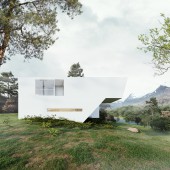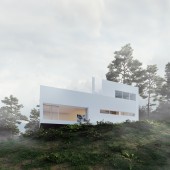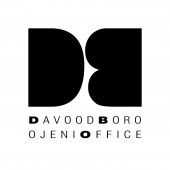Villa Gilbam Residential House by Davood Boroojeni |
Home > Winners > #132788 |
 |
|
||||
| DESIGN DETAILS | |||||
| DESIGN NAME: Villa Gilbam PRIMARY FUNCTION: Residential House INSPIRATION: Factors such as the desired spatial quality, local architecture, climate, and exposed usage of materials have been considered in the project design. We believe that the beautiful innovative useful architecture of Villa Gilbam is the result of using the above-mentioned factors in the project simultaneously. The angle of the three volumes of the villa relative to each other was adjusted in a way to create a shared space in the heart of the building. This space has a perfect and extraordinary view of the surrounding mountains. UNIQUE PROPERTIES / PROJECT DESCRIPTION: In the plan of Villa Gilbam, solutions have been found for issues, including the location that the villa should be established there, the impacts of climate and neighborhood on its design, and the desired quality of the shared space. OPERATION / FLOW / INTERACTION: One of our primary design goals was material disclosure. We believe that the use of exposed materials not only creates an indigenous feeling in the spaces but also causes less damage to the environment. PROJECT DURATION AND LOCATION: The design of the project started in June 2016 and finished in December 2016 in Tehran. FITS BEST INTO CATEGORY: Architecture, Building and Structure Design |
PRODUCTION / REALIZATION TECHNOLOGY: The project land with an approximate area of 750 square meters is located on the slopes of one of the mountains in northern Iran in the Siahkal region. The land with an unknown geometry has a slope of about 10% from east to west. In the east of the land, and in a rectangle section measuring 8 × 15 meters, intrusion and seizure were seen; as if this rectangle had been a place of a building in the past. The project’s employer has needed a place with an area of 350 square meters. SPECIFICATIONS / TECHNICAL PROPERTIES: Due to the fact that climate and neighborhood were not the limiting factors for the location of the villa, the east of the land, which used to be a place of another building in the past, was allocated for this purpose. With the aim of minimizing intrusion and seizure of the area, the connection surface of the villa to the land was limited to the same rectangle of the old building with dimensions of about 8 × 15 meters. To meet the demands of the employer, which required 350 square meters, two console volumes were added to the initial core of the project at ground level and the first floor without connecting to the ground. TAGS: - RESEARCH ABSTRACT: The current project design is a quantitative and qualitative one. The most important goals are achieving proper functioning, creating the desired spatial quality, resuscitation of the middle courtyard as patterns of indigenous architecture, and reducing energy and construction material consumption. To achieve the goals of the project Field observation, study of the needs of the client, study of historical texts, the study of architectural standards, technical characteristic observation Of materials, the study of regional climate have been considered. CHALLENGE: The two console volumes at the height have slid over each other in such a way that neither of them obstructs the proper light of the south and the proper view of the north and south for each other. The console volume located on the ground floor level is in the south and the first level console volume is located in the north. Suitable light from the south passes over the southern volume and reaches the northern volume. Also, the northern volume has a good view of the southern mountains. Below the northern volume is empty and the southern volume overlooks the northern landscape. The angle of the three volumes of the villa relative to each other was adjusted in a way to create a shared space in the heart of the building. This space has a perfect and extraordinary view of the surrounding mountains. ADDED DATE: 2021-11-06 16:54:27 TEAM MEMBERS (2) : Principal Architects: Davood Boroojeni - Saba Ammari and CG Artist: Peyman Nozari IMAGE CREDITS: Image #1: Illustrator Peyman Nozari, 2021. Image #2: Illustrator Peyman Nozari, 2021. Image #3: Illustrator Peyman Nozari, 2021. Image #4: Illustrator Peyman Nozari, 2021. Image #5: Illustrator Peyman Nozari, 2021. |
||||
| Visit the following page to learn more: https://www.instagram.com/davoodboroojen |
|||||
| AWARD DETAILS | |
 |
Villa Gilbam Residential House by Davood Boroojeni is Winner in Architecture, Building and Structure Design Category, 2021 - 2022.· Read the interview with designer Davood Boroojeni for design Villa Gilbam here.· Press Members: Login or Register to request an exclusive interview with Davood Boroojeni. · Click here to register inorder to view the profile and other works by Davood Boroojeni. |
| SOCIAL |
| + Add to Likes / Favorites | Send to My Email | Comment | Testimonials | View Press-Release | Press Kit |
Did you like Davood Boroojeni's Architecture Design?
You will most likely enjoy other award winning architecture design as well.
Click here to view more Award Winning Architecture Design.








